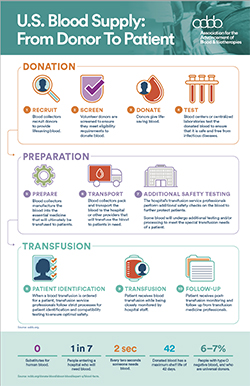Donating blood is a safe, simple, and rewarding experience that usually only takes 45-60 minutes.
Before You Donate
 To
donate blood, find a blood donation facility near you using AABB’s Blood Bank Locator. Then, call the facility to
make an appointment. Blood can also be donated during a blood drive, which may be held at a place of business, high school or college, place of worship, community center or bloodmobile. When making the appointment, ask the following questions:
To
donate blood, find a blood donation facility near you using AABB’s Blood Bank Locator. Then, call the facility to
make an appointment. Blood can also be donated during a blood drive, which may be held at a place of business, high school or college, place of worship, community center or bloodmobile. When making the appointment, ask the following questions:
- What are your general donor requirements? (Most places require you to weigh a minimum of 110 pounds, be at least 16 years old and be generally healthy).
- What kind of identification is required? (First-time donors are usually asked to present two forms of identification—the type of identification needed varies by facility).
- If you have any particular health concerns or have traveled outside of the country, it’s also a good idea to inform the blood bank at the time you are making your appointment.
Feel good about your decision! AABB sets standards to ensure patient and donor safety. Accredited facilities undergo a rigorous assessment to prove they meet AABB’s high standards, which ensure optimal safety for donors and patients.
Pre-Donation Screening
- During pre-donation screening, a blood bank employee will ask you some questions about your health, lifestyle, and disease risk factors. All of this information is confidential.
- An employee will perform a short health exam, taking your pulse, temperature and blood pressure.
- A drop of blood from your finger will also be tested to ensure that your blood iron level is sufficient for you to donate. All medical equipment used for this test, as well as during the donation process, is sterile, used only once and then disposed.
Blood Donation
- Once the pre-donation screening is finished, you will proceed to a donor bed where your arm will be cleaned with an antiseptic, and a professional will use a blood donation kit to draw blood from a vein in your arm. If you are allergic to iodine,
be sure to tell the phlebotomist at this point.
- During the donation process, you will donate one unit of blood; this takes about six to ten minutes.
Post-Donation
- Following your donation, you will receive refreshments in the canteen area, where you can stay until you feel strong enough to leave.
- After donating, it is recommended that you increase your fluid intake for the next 24 to 48 hours; avoid strenuous physical exertion, heavy lifting or pulling with the donation arm for about five hours; and eat well balanced meals for the next 24
hours. After donating, smoking and alcohol consumption is not recommended.
- Although donors seldom experience discomfort after donating, if you feel light-headed, lie down until the feeling passes. If some bleeding occurs after removal of the bandage, apply pressure to the site and raise your arm for three to five minutes.
If bruising or bleeding appears under the skin, apply a cold pack periodically to the bruised area during the first 24 hours, then warm, moist heat intermittently.
If you have any questions concerning your donation or experience any unexpected problems, please call the facility where you donated blood.
 To
donate blood, find a blood donation facility near you using AABB’s Blood Bank Locator. Then, call the facility to
make an appointment. Blood can also be donated during a blood drive, which may be held at a place of business, high school or college, place of worship, community center or bloodmobile. When making the appointment, ask the following questions:
To
donate blood, find a blood donation facility near you using AABB’s Blood Bank Locator. Then, call the facility to
make an appointment. Blood can also be donated during a blood drive, which may be held at a place of business, high school or college, place of worship, community center or bloodmobile. When making the appointment, ask the following questions: